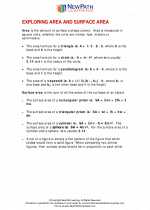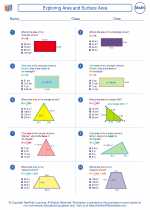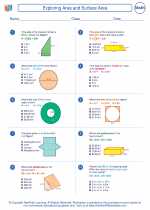Exploring Area and Surface Area
Area
In mathematics, the area of a shape is the amount of space inside the shape. The formula for finding the area of a rectangle is:
Area = Length × Width
For a square, where all sides are equal, the formula simplifies to:
Area = Side Length × Side Length
For a triangle, the formula is:
Area = 0.5 × Base × Height
Surface Area
Surface area is the total area of all the surfaces of a 3D object. The surface area of a cube is given by:
Surface Area = 6 × (Side Length)²
For a rectangular prism, the formula is:
Surface Area = 2 × (Length × Width + Length × Height + Width × Height)
For a cylinder, the formula is:
Surface Area = 2πr² + 2πrh
Study Guide
- Understand the concept of area and how it is different from perimeter.
- Learn the formulas for finding the area of rectangles, squares, and triangles.
- Practice applying the area formulas to solve problems involving different shapes.
- Study the concept of surface area and how it relates to 3D shapes.
- Memorize the surface area formulas for cubes, rectangular prisms, and cylinders.
- Work on problems that involve finding the surface area of various 3D objects.
◂Math Worksheets and Study Guides Seventh Grade. Exploring Area and Surface Area
Study Guide Exploring Area and Surface Area
Exploring Area and Surface Area  Worksheet/Answer key
Worksheet/Answer key Exploring Area and Surface Area
Exploring Area and Surface Area  Worksheet/Answer key
Worksheet/Answer key Exploring Area and Surface Area
Exploring Area and Surface Area  Worksheet/Answer key
Worksheet/Answer key Exploring Area and Surface Area
Exploring Area and Surface Area  Worksheet/Answer key
Worksheet/Answer key Exploring Area and Surface Area
Exploring Area and Surface Area 

 Worksheet/Answer key
Worksheet/Answer key
 Worksheet/Answer key
Worksheet/Answer key
 Worksheet/Answer key
Worksheet/Answer key
 Worksheet/Answer key
Worksheet/Answer key

The resources above cover the following skills:
Geometry (NCTM)
Analyze characteristics and properties of two- and three-dimensional geometric shapes and develop mathematical arguments about geometric relationships.
Precisely describe, classify, and understand relationships among types of two- and three-dimensional objects using their defining properties.
Use visualization, spatial reasoning, and geometric modeling to solve problems.
Use geometric models to represent and explain numerical and algebraic relationships.
Measurement (NCTM)
Apply appropriate techniques, tools, and formulas to determine measurements.
Select and apply techniques and tools to accurately find length, area, volume, and angle measures to appropriate levels of precision.
Develop and use formulas to determine the circumference of circles and the area of triangles, parallelograms, trapezoids, and circles and develop strategies to find the area of more-complex shapes.
Develop strategies to determine the surface area and volume of selected prisms, pyramids, and cylinders.
Grade 7 Curriculum Focal Points (NCTM)
Measurement and Geometry and Algebra: Developing an understanding of and using formulas to determine surface areas and volumes of three-dimensional shapes
By decomposing two- and three-dimensional shapes into smaller, component shapes, students find surface areas and develop and justify formulas for the surface areas and volumes of prisms and cylinders. As students decompose prisms and cylinders by slicing them, they develop and understand formulas for their volumes (Volume = Area of base x Height). They apply these formulas in problem solving to determine volumes of prisms and cylinders. Students see that the formula for the area of a circle is plausible by decomposing a circle into a number of wedges and rearranging them into a shape that approximates a parallelogram. They select appropriate two- and three-dimensional shapes to model real-world situations and solve a variety of problems (including multi-step problems) involving surface areas, areas and circumferences of circles, and volumes of prisms and cylinders.